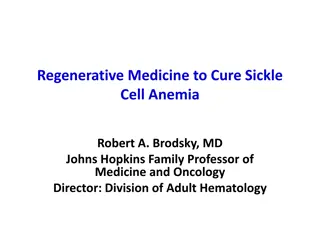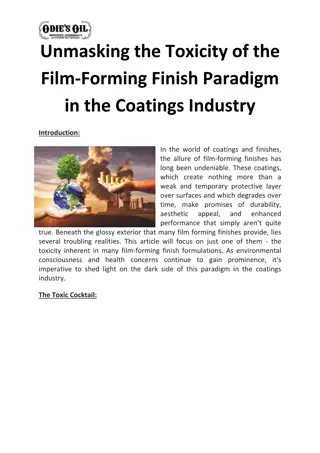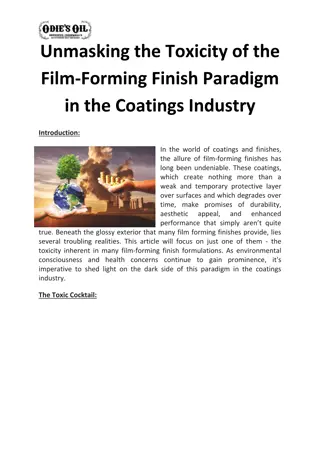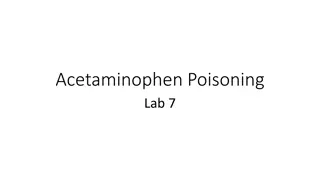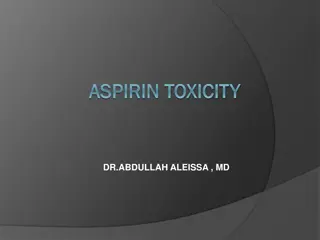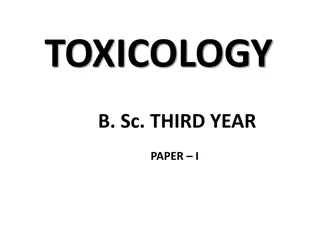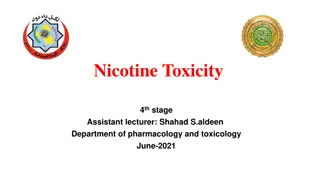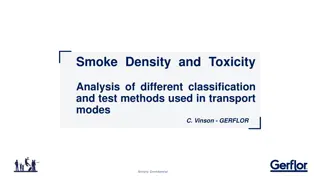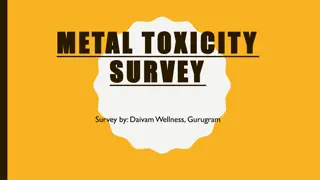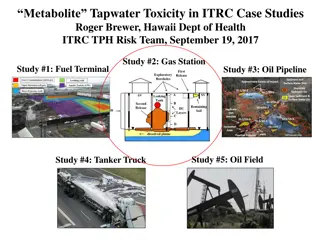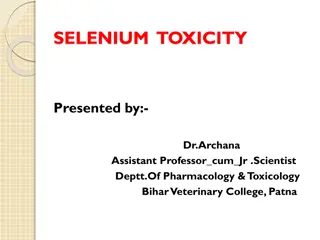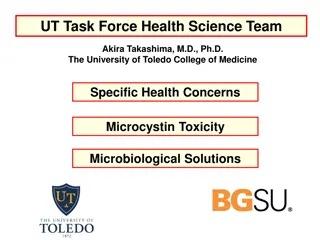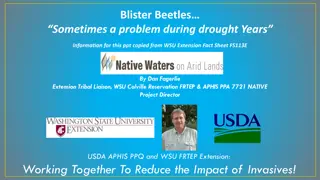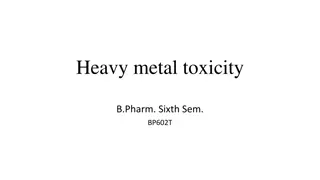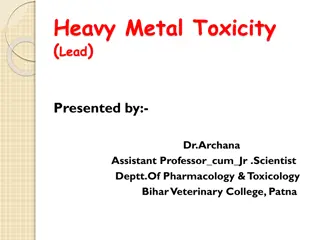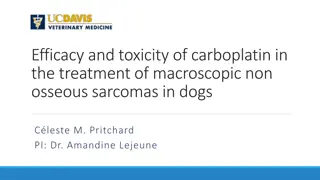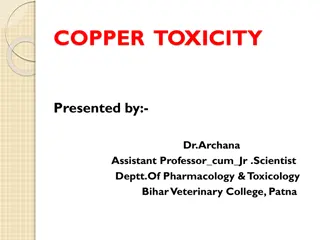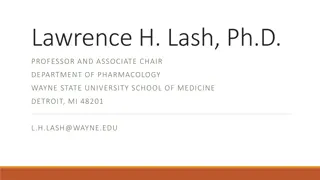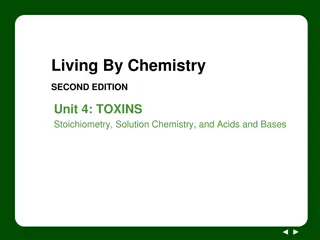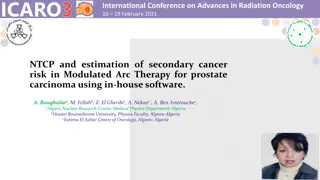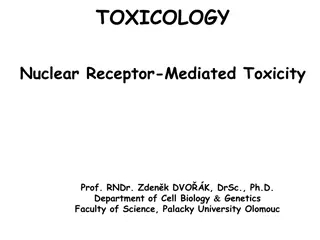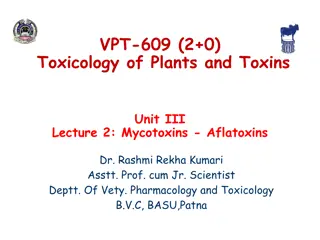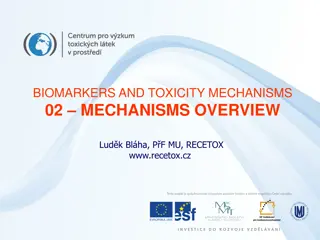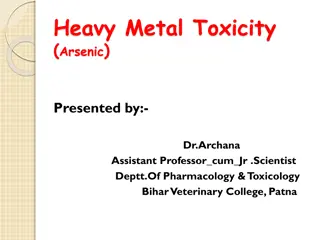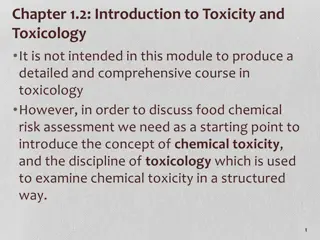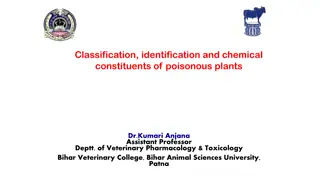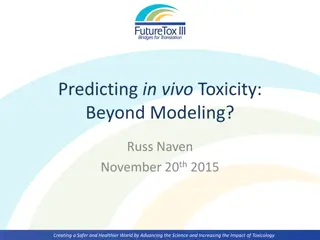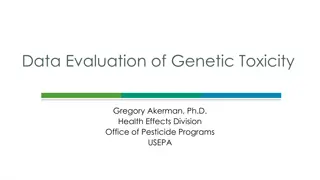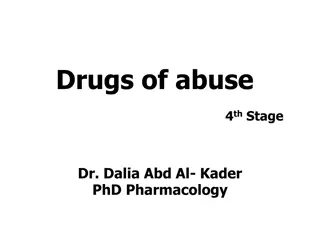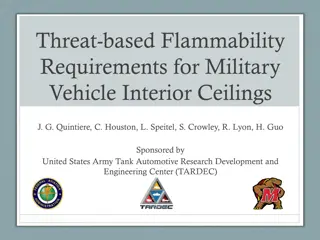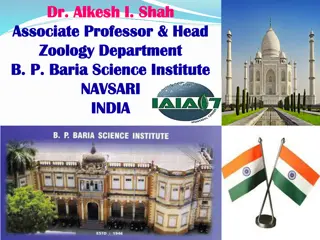Advancements in Regenerative Medicine for Sickle Cell Anemia
Regenerative medicine holds promise for treating sickle cell anemia through techniques like stem cell transplantation. This approach targets genetic blood diseases, offering potential cures beyond traditional uses like eradicating cancer. Despite obstacles like toxicity and donor availability, innov
10 views • 26 slides
Unmasking the Toxicity of the Film-Forming Finish Paradigm in the Coatings Industry
Exposure to toxic fumes emitted by film-forming finishes during application and drying poses significant health hazards to workers and occupants of coated spaces. Painters, contractors, and DIY enthusiasts are particularly vulnerable to inhaling harmful chemicals, leading to respiratory ailments, he
1 views • 5 slides
Unmasking the Toxicity of the Film-Forming Finish Paradigm in the Coatings Industry
Exposure to toxic fumes emitted by film-forming finishes during application and drying poses significant health hazards to workers and occupants of coated spaces. Painters, contractors, and DIY enthusiasts are particularly vulnerable to inhaling harmful chemicals, leading to respiratory ailments, he
1 views • 5 slides
Acetaminophen Poisoning: Mechanism, Toxicity, and Treatment
Acetaminophen poisoning occurs when the body is overwhelmed by high doses of the drug, leading to liver toxicity and potentially fatal consequences. The mechanism of toxicity involves the depletion of glutathione and the formation of a harmful metabolite, N-acetyl-para-benzoquinoneimine (NAPQI). Con
2 views • 9 slides
Aspirin Toxicity: Overview and Management
Aspirin toxicity, though decreasing in incidence, can still result in severe consequences such as metabolic acidosis, seizure, and even death. This condition is often underestimated due to lack of familiarity with its clinical presentation. Treatment focuses on maintaining salicylate in the ionized
0 views • 22 slides
Toxicology
The study of toxicology involves understanding dose-response relationships, lethal concentrations, tolerance limits, toxicity curves, and factors influencing toxicity. Dose, response, acute toxicity, chronic toxicity, LD50, and ED50 are key concepts in toxicology that help assess the effects of chem
3 views • 24 slides
Nicotine Toxicity: A Comprehensive Overview
Nicotine, a toxic substance found in tobacco plants, has therapeutic uses in treating nicotine dependence. However, exposure to nicotine can lead to toxicity, with symptoms such as Green Tobacco Sickness (GTS). Understanding the absorption, distribution, and metabolism of nicotine is crucial in mana
1 views • 19 slides
Analysis of Smoke Density and Toxicity in Various Transport Modes
This document presents an in-depth analysis of smoke density and toxicity in different transport modes, including maritime, railway, and aircraft. It covers classification documents, testing methods, hazard levels, and measured parameters for evaluating smoke density and toxicity levels. The synthes
0 views • 6 slides
Metal Toxicity: Risks, Detection, and Impact on Health
Metal toxicity is a growing concern affecting many individuals today, with 41% of Delhi & NCR population testing positive for severe heavy metal toxicity. This survey by Daivam Wellness aims to create awareness about the dangers of metal toxicity and its impact on health, including diseases such as
1 views • 7 slides
Advances in Antimicrobial Drugs: Selective Toxicity and Classification
The development of antimicrobial drugs has significantly improved therapeutics by controlling infections and preventing complications. These drugs target invading microorganisms using selective toxicity, sparing host cells. Antimicrobial drugs are classified based on site, mechanism of action, and c
2 views • 30 slides
Petroleum Metabolite Toxicity in Environmental Case Studies
Exploring the impact of metabolites from petroleum degradation on tap water toxicity through case studies involving gas stations, fuel terminals, oil pipelines, oil fields, and tanker trucks. The assessment of TPH risk levels in different settings, calculation of screening levels for drinking water,
0 views • 17 slides
Selenium Toxicity in Animals: Sources, Mechanism, and Clinical Signs
Selenium toxicity in animals can occur through various sources such as selenium-containing plants. The toxicokinetics involve absorption from the gut and distribution to different body parts. The mechanism of toxicity is linked to the incorporation of selenium in amino acids and proteins, leading to
0 views • 10 slides
Comprehensive Approach to Address Microcystin Toxicity and Solutions by UT Health Science Team
The UT Task Force Health Science Team, led by experts in various fields, focuses on addressing specific health concerns related to Microcystin toxicity. They employ a multidisciplinary approach, utilizing expertise in clinical medicine, public health, microbiology, and molecular biology. The team pr
0 views • 7 slides
Cardiotoxic Glycosides in Plants: Toxicity and Mechanism of Action - Overview
Plants like Nerium oleander, Thevetia peruviana contain cardiotoxic glycosides causing toxicity in animals and humans. Poisoning with these plants can be fatal, affecting the heart and nerves. Toxicity is mainly due to compounds like oleandroside and oleandrin, leading to cardiac failure and gastroi
0 views • 13 slides
Overview of Veterinary Toxicology Syllabus and Topics Covered
Detailed overview of the Veterinary Toxicology syllabus including general toxicology, toxicity caused by metals and non-metals, poisonous plants, agrochemical toxicity, fungal and bacterial toxins, venomous bites and stings, and more. The syllabus covers a wide range of topics related to toxicology
0 views • 12 slides
Blister Beetles and Livestock Toxicity: Impacts and Management
Blister beetles are a biological control agent of grasshoppers but can become a problem, especially during drought years. This presentation discusses how blister beetles develop, their impact on plants and livestock, and the toxicity of cantharidin found in these beetles. Livestock, especially horse
0 views • 9 slides
Heavy Metal Toxicity: Lead and Mercury Poisoning
Lead and mercury poisoning are serious health concerns caused by exposure to these toxic heavy metals. Lead, commonly found in products like batteries and paints, can lead to developmental delays, abdominal pain, and more. On the other hand, mercury, present in various forms, can cause symptoms such
0 views • 6 slides
Lead Toxicity: Sources, Symptoms, and Treatment in Animals
Lead toxicity, or lead poisoning, can have serious health implications for animals, particularly in cases of ingestion through contaminated sources. This article discusses the sources, toxicokinetic processes, clinical signs, and treatment of lead toxicity in veterinary medicine, highlighting the im
0 views • 14 slides
Efficacy and Toxicity of Carboplatin in the Treatment of Canine Non-Osseous Sarcomas
The study evaluates the efficacy and toxicity of carboplatin in treating macroscopic non-osseous sarcomas in dogs. The research focuses on soft tissue sarcomas (STS) and mesenchymal tumors, exploring carboplatin's limitations, response rates, and toxicity profiles. Aimed at determining the drug's ef
0 views • 15 slides
Copper Toxicity in Veterinary Science
This presentation by Dr. Archana explores the terminology, sources, toxicokinetics, mechanisms of toxicity, clinical signs, and treatment options related to copper toxicity in animals. It discusses how copper absorption, retention, and elimination are affected by dietary factors, leading to copper a
0 views • 11 slides
Selective Leaching in Materials Engineering
Selective leaching, also known as de-alloying, is the process of selectively removing one element from an alloy through corrosion. Dezincification in brass is a common example of this phenomenon, where zinc is preferentially attacked, leaving behind a weakened copper structure. It can occur in diffe
0 views • 14 slides
Key Issues and Uncertainties in Tert-Butanol (TBA) Induced Kidney Toxicity
This study discusses the key issues and uncertainties surrounding Tert-Butanol (TBA) induced kidney toxicity. It covers the role of alpha-2u globulin nephropathy, chronic progressive nephropathy (CPN), and the validity of concluding another unknown mode of action. Findings suggest TBA as a weak indu
0 views • 8 slides
Toxicity Through Stoichiometry and Molar Mass
Delve into the world of toxicity analysis by comparing the amounts of different substances using moles and molar mass. Explore the safety of sweeteners and learn how to utilize these concepts to assess toxicity levels. Engage in thought-provoking discussions and activities to deepen your understandi
0 views • 10 slides
Selective Breeding: Benefits and Process
Selective breeding is a method where humans control the breeding of organisms to emphasize or eliminate specific traits. By choosing parents with desirable characteristics, breeders aim to create offspring with those traits. While advantageous for creating economically important varieties, it can al
0 views • 12 slides
NTCP and Secondary Cancer Risk in Modulated Arc Therapy for Prostate Carcinoma
Prostate cancer, a significant health concern worldwide, has seen advancements in treatment with the adoption of IMRT. However, the use of radiotherapy poses risks of inducing secondary cancers due to organ toxicity. A study presented at ICARO3 focused on evaluating the toxicity of organs at risk an
0 views • 6 slides
Nuclear Receptor-Mediated Toxicity: Molecular Insights and Implications
TOXICOLOGY research on Nuclear Receptor-Mediated Toxicity by Prof. Zdeněk Dvořák delves into the evidence, molecular properties, structures, and signaling pathways of nuclear receptors such as Aryl Hydrocarbon Receptor (AhR). Detailed information on the impact of AhR-mediated toxicity, including
0 views • 19 slides
Aflatoxins: Mycotoxins and Toxicology in Plants
Mycotoxicoses refers to illnesses in humans or animals caused by ingesting substances produced by certain molds or fungi on food. Aflatoxins are a type of mycotoxin that are potent mutagens, carcinogens, teratogens, and liver damage agents. They were first discovered in the 1960s and are known to be
0 views • 16 slides
Biomarkers and Toxicity Mechanisms: Overview of Mechanisms in Targeting Biological Macromolecules
This overview delves into different categorizations of mechanisms of action (MoA) based on target molecules, interaction types, and steric specificity. It explores non-specific and specific mechanisms, along with possible categorizations involving membrane toxicity, reactive toxicity, and species-sp
0 views • 8 slides
Arsenic Toxicity: Mechanisms, Effects, and Treatment
Arsenic toxicity is a significant concern due to its presence in various sources like pesticides and industrial activities. This heavy metal can lead to severe health issues by interfering with normal physiological functions. Chelating agents play a crucial role in managing arsenic poisoning by form
0 views • 13 slides
Introduction to Toxicity and Toxicology in Food Chemical Risk Assessment
This module introduces the concept of chemical toxicity and the discipline of toxicology in relation to food chemical risk assessment. It touches upon historical aspects, such as the case of Socrates' death by hemlock, the contributions of Mathieu Joseph Bonaventure Orfila in forensic toxicology, an
0 views • 18 slides
Overview of Poisonous Plants: Classification, Identification, and Toxic Chemical Constituents
This detailed chapter delves into the classification, identification, and chemical constituents of poisonous plants, shedding light on natural toxins, alkaloids, and toxic principles. It covers the role of alkaloids in plant toxicity, highlighting specific types such as piperidine alkaloids, pyrroli
0 views • 17 slides
Advancing In Vivo Toxicity Prediction Beyond Modeling
Explore the challenges and opportunities in predicting in vivo toxicity beyond traditional models. Learn about confidence in toxicity prediction, recently discontinued drugs due to safety concerns, and the importance of recognizing toxicological signals in preclinical stages. Discover how computatio
0 views • 27 slides
Evaluation of Genetic Toxicity in Pesticide Programs - Data Overview
The presentation by Dr. Gregory Akerman discusses the evaluation of genetic toxicity, focusing on genotoxicity data for glyphosate, including gene mutation, chromosomal abnormality, and primary DNA damage. It explores the consequences of genotoxicity, such as cancer risks and cell death, along with
0 views • 27 slides
Cocaine: Effects, Risks, and Complications
Cocaine is a powerful stimulant that affects the central nervous system, causing intense euphoria followed by a crash. Its effects include CNS stimulation, pleasure center activation, and potential toxicity from adulterants. Cocaine is commonly abused with alcohol, creating a cardiotoxic metabolite.
0 views • 22 slides
Threat-Based Flammability Requirements for Military Vehicle Interior Ceilings
This study focuses on developing a test protocol to evaluate the fire thermal and toxicity hazards of ceiling cushioning materials in armored military vehicles during accidental or war fire ignition incidents. The approach involves establishing specific ignition threats and toxicity exposure criteri
0 views • 12 slides
Heavy Metal Toxicity: Impacts on Aquatic Life and Human Health
Heavy metal toxicity poses a significant threat to both aquatic ecosystems and human health, with various heavy metals accumulating in the environment and food chain. This overview highlights the adverse effects of heavy metals like copper, nickel, zinc, cobalt, and cadmium on physiological processe
0 views • 39 slides
Housing Standards Update: Melcombe Regis Selective Licensing and Alternative Proposal
Housing Standards Service Manager Richard Conway provides an update on the progress of the Melcombe Regis Selective Licensing initiative and explores an alternative proposal involving voluntary landlord accreditation and targeted enforcement to improve housing standards. The Executive Advisory Panel
0 views • 7 slides
Selective COX Selective COX- -2 Drugs &
Selective COX-2 inhibitors are a new group of drugs providing potent anti-inflammatory activity without significant GI toxicity. Celecoxib, the first marketed COX-2 inhibitor, is followed by rofecoxib and valdecoxib. Etoricoxib, approved worldwide except in the US, offers stronger analgesic efficacy
0 views • 24 slides
Aspirin toxicity
Aspirin toxicity is a serious concern that requires prompt attention. Dr. Mohammed Arafat, an experienced emergency medicine consultant, specializes in managing cases of aspirin overdose. His expertise in this area ensures effective treatment and care for patients facing aspirin-related complication
0 views • 27 slides
Current Work and Future Trends in Selective Disclosure
The article discusses current practices and upcoming trends related to selective disclosure in various fields. It explores the impact, benefits, and challenges associated with the process, offering insights into future developments and strategies in this domain. Readers will gain a comprehensive und
0 views • 38 slides
